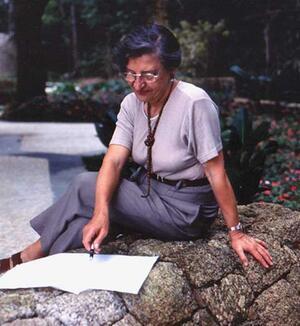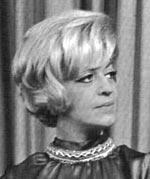Rosa Grena Kliass
Rosa Kliass is a trailblazer in the field of Brazilian landscape architecture. After graduating from university, Kliass established the first landscape office run by a woman in Brazil. Kliass was responsible for the landscape design of the international airports of Brasília and Belém, in the north of Brazil. She created a garden pattern using new materials and techniques to be reproduced in the residential buildings of the real-estate company Hindi. Kliass’ extensive experience in public works, combined with a broad interdisciplinary approach, led her to serve as a consultant to several governmental institutions. During the 1980s, she worked as Director of Planning for the São Paulo City Department of Planning (SEMPLA) and as a member of the Administration Council of CETESB (Environmental Sanitation and Technology Company).
Family and Education
Landscape architect Rosa Grena Kliass was born in São Roque, Brazil, in the hinterland of the state of São Paulo, on October 15, 1932. Her father, José Alembick (1899–1973), was born in Stertzev (Szczerców), Poland, spoke Polish and Yiddish, and, according to his daughter, became involved with the Bund in 1923, when he left his (Yiddish) Small-town Jewish community in Eastern Europe.shtetl soon after his first marriage, to Rivka Rotstein. The couple lived in Belchatow, where their three children were born—Maria (Gorski, b. 1924), Masza (1924–1932,) and Lejbus (b. 1928). José Alembick arrived in Brazil in 1930 and began to work as a clientelchik (door-to-door salesman). Meanwhile his wife fell seriously ill, was hospitalized, and died in 1932. The three children were sent to Brazil, where Masza died upon arrival.
Rosa’s mother, José’s second wife, Sonia (Shura) Alembick (née Groisman, 1900–1962), was from Beltz (Belz) in Bessarabia and arrived in Brazil in 1931, settling in São Roque, where her sister lived. Here the couple settled after marrying in 1932 and José Alembick began to manufacture furniture. Since there were few Jewish families in the town, the family spent the important religious festivals in Sorocaba, where the Jewish community had built a synagogue.
Rosa went to primary school in São Roque but in 1944 moved to São Paulo to continue her studies at the state secondary school. She lived in the district of Bom Retiro, which between the 1930 and 1950 was the main Jewish area in São Paulo. Rosa graduated in architecture at the Faculty of Architecture and Urbanism of the University of São Paulo, where she studied between 1951 and 1955. At that time, the course in Landscape Design was taught in the final year by the American landscape designer Roberto Coelho Cardozo, who, having studied and worked with Garrett Eckbo at the University of California at Berkeley, was a well-known professional within Sao Paulo’s modern circles. Through Cardozo, Rosa had contact with the California school of architecture, represented by Thomas Church, Garret Eckbo, and Lawrence Halprin.
While in school, Kliass worked as an intern at important architecture offices in Sao Paulo, such as the one owned by architect Abelardo de Souza, who came to maturity within the Carioca modern architecture circles, as well as at Rino Levi’s office, one of the most important representatives of the modern Paulista architecture. Of Italian-Jewish origin, Levi had studied in the Preparatory School for Civil Architects in Milan from 1921 to 1923, graduating from the Higher School of Architecture in Rome in 1925. Through Levi Rosa met the landscape designer Roberto Burle Marx, the most important Brazilian representative in the field and the longtime partner of Oscar Niemeyer, who had introduced the use of tropical vegetation in Brazilian design. Before her graduation Kliass worked also with Jorge Wilheim, then a young urbanist architect with whom she developed her first urban design for Angelica in the state of Mato Grosso do Sul.
In 1956 Rosa married her colleague, architect Wlademir Kliass (1929–1985), and the two began working together in architectural design. Wlademir was the son of the recognized piano teacher José Kliass, a pupil of Martin Krause, who in turn had been one of the last pupils of Franz Liszt. Kliass had disciples like his close relatives Estelinha Epstein (1914-1980) and Yara Bernette (1920-2002), as well as Anna Stella Schic (1925-2009) and Joao Carlos Martins (1940). Rosa and Wlademir had two children, Paulo (b. 1958) and Sonia (b. 1964).
Early Career
Rosa Kliass’s first landscape design assignment complemented the architecture projects created by the architecture firm Forte Gandolfi Associated architects, formed by the Paulistas architects Luiz Forte Netto, José Maria Gandolfi, and Roberto Luis Gandolfi, who had established themselves in Curitiba. She began designing residential gardens and already in 1962 was responsible for the landscape of the Clube Santa Monica. In 1965 she participated with Jorge Wilheim in Curitiba’s master plan, enabling her to discuss and develop a methodology for landscape planning.
In 1966 Kliass designed her first public park in Sao Paulo, the Morumbi Park, a project that led to the creation of the city’s Departmento de Parques de Áreas Verdes [Department of Parks and Green Areas], which was responsible for ensuring free areas within the urban space. This initiative can be understood as the transition in Rosa's practice from the scale of vegetation to city’s scale.
In 1969 Kliass received support from USAID to visit the most important landscape architecture offices in the United States, as well as schools of landscape design and municipal park and recreation departments. She traveled through the country for three months, returning to Brazil very much impressed with the planning and interdisciplinary approach proposed by the landscape designer Ian McHarg who had just published Design with Nature (1969). Kliass completed her M.A. in Urban Planning at the faculty of architecture of the University of São Paulo.
Rosa Grena Kliass Landscape Planning and Projects
In 1970 Kliass established her own office, Rosa Grena Kliass Landscape Planning and Projects Ltd. (RGKPP), the first landscape office run by a woman in Brazil. Her ease in moving through governmental and entrepreneurial spheres widened the possibilities for public, institutional, and private commissions of various scales throughout Brazil, from the Servico Social do Comercio (SESC) (a partnership that began in the 1970s with the architecture office Botti e Rubin and included the design of the large area of SESC Centro Campestre, which she developed with the assistance of the German immigrant botanist Harry Blossfeld) to the planning of green areas in cities all around the country. She planned green spaces in São Paulo (Parque Metropolitano Sul, 1973), Curitiba, Salvador, Belém do Pará, and Maraba, developing master plans for urban landscape for the cities of São Luis do Maranhão and Macapá. Moreover. Kliass conceived landscape projects for avenues and squares such as the Paulista Avenue (in which she recovered the use of Portuguese mosaic, 1973), and redesigned the Anhangabaú Valley (a project that won a national prize) in São Paulo. In Salvador (Bahia), Rosa was involved in redesigning the traditional area of the Abaete lagoon, in the city of Macapa she developed the landscape plans for the eighteenth-century Portuguese fortress Fortaleza de São José, and in Sao Paulo, she designed the Parque da Juventude, on the grounds of the former prison complex (Carandiru) in partnership with the Aflalo and Gansperini architecture office.
Kliass was responsible for the landscape design of the international airports of Brasília and Belém, in the north of Brazil. In the 1970s she created a garden pattern using new materials and techniques to be reproduced in the residential buildings of the real-estate company Hindi.
Government and Academic Work
Kliass’ extensive experience in public works, combined with a broad interdisciplinary approach, led her to serve as consultant to several governmental institutions, such as the Department of Economics and Planning of the State of São Paulo; the Department of Water and Electrical Energy (DAEE); the Municipality of São José dos Campos, São Paulo State; and the Metropolitan Agency for Housing (COHAB), São Paulo. During the 1980s, she worked as Director of Planning for the São Paulo City Department of Planning (SEMPLA) and as a member of the Administration Council of CETESB (Environmental Sanitation and Technology Company).
Although she only presented her thesis in 1989, Rosa Kliass was involved in academic life long before, teaching and coordinating courses in landscape architecture at the Faculty of Architecture and Urbanism of Mackenzie University (1974–1977, São Paulo), the School of Architecture and Urbanism at the Catholic University of Paraná (1980-1982, Curitiba), as well as the Faculty of Architecture and Urbanism Bras-Cubas (1981, Mogi das Cruzes). Nevertheless, her major contribution to the field involves her full engagement in strengthening the profession nationally, through the foundation in 1976 of the Brazilian Association of Landscape Architects (ABAP), which she directed during various periods in the 1980s and again in the 1990s until 2000. From within the ABAP, Kliass’ greatest efforts were directed toward creating dialogue between Brazilian professionals and the international milieu represented by the International Federation of Landscape Architects (IFLA), whose 1978 World Congress she promoted and coordinated with success in Salvador, Bahia. Similarly, in 1993 she organized the first meeting of landscape teachers in Brazil, which turned into the permanent event known as the National Meeting of Landscaping Teaching in Architecture Schools (Enepea). Kliass also served one term as secretary of the IFLA’s Western Region (Americas), as well as its vice-president between 2000 to 2002, during which organized the organization’s Regional meeting in the city of Belém do Pará, a city to which she had contributed with important projects.
In 2005 Kliass was honored with a special room at the 6th Sao Paulo International Biennial of Architecture.
Costa, Lucia Maria Sá Antunes, and Maria Cecilia Barbieri Gorski, ed. Rosa Grena Kliass. O livro da Rosa. Vivências e paisagens, ed. São Paulo: Romano Guerra, 2019.
Zein, Ruth Verde. Rosa Kliass. Desenhando paisagens, moldando uma profissão. São Paulo: Editora SENAC, 2006
Barbosa, Antonio Agenor, Rachel Paterman, and Stella Rodrigues. “Entrevista com a arquiteta paisagista Rosa Kliass.” Vitruvius, Vol. 16, Augut 2015.




